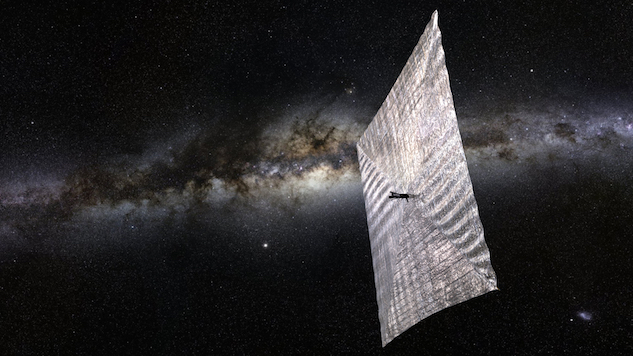
Space Matter is a weekly column that delves into space science and the mechanics of spaceflight. From the latest discoveries in the universe around us to the fits and starts of rocket test flights, you’ll find analysis, discussion and an eternal optimism about space and launching ourselves into the cosmos.
![]()
A solar sail: It sounds romantic and fantastical, but what is it exactly? The image of a spacecraft sailing among the stars, much like a sailing vessel on our ocean, is powerful. But the analogy isn’t exactly correct; to put it succinctly, solar sail spacecraft are craft that rely on pressure from solar radiation (not solar wind) for propulsion.
The sun gives off an immense amount of radiation, and it affects our life here on Earth. Think: auroras, geomagnetic storms, and more. We’re thankfully protected by our planet’s large magnetic field; outside of our planet’s atmosphere, though, spacecraft are vulnerable to solar radiation. This radiation, in the form of photons, has no mass but it has both energy and momentum. Solar sail spacecraft are equipped with sails covered in a mirrored material. When photons bounce off these reflective sails, it propels the craft, working as a sort of engine. The acceleration is slow, but steady, and over time, solar sail craft can reach high speeds.
Solar sails have a long and colorful history. The ability to sail through the stars was first posited four centuries ago by Johannes Kepler after he observed comets with their long tails through a telescope. Over the years, we’ve refined our understanding of how solar sails could work (and most importantly, that they’re dependent on solar radiation, rather than solar wind, to function). Since the 1970s, we’ve been using solar sails in a limited manner on spacecraft and satellites, but they haven’t seen wide or regular use in space. That might be about to change, thanks to The Planetary Society.
The Planetary Society is a nonprofit space travel advocacy organization founded by Carl Sagan, Bruce Murray, and Louis Friedman in 1980. Its current CEO is Bill Nye. Neil deGrasse Tyson is on its Board of Directors. It’s got some serious science chops, and now it’s getting into the spacefaring business with its solar sailing craft, LightSail 2.
The LightSail project relies on CubeSat technology. CubeSats are at the core of the current small satellite revolution. They are miniaturized satellites that come in standard size increments—roughly 10 × 10 x 10 cm. Satellites can be composed of multiple CubeSats; the idea is to work in multiples of the given dimensions. This makes the costs of deployment into space predictable and reduces the risk inherent in launching. Their small, standardized size also makes them easier to launch because they can piggyback on larger payloads.
 The first LightSail as a CubeSat. Photo courtesy of The Planetary Society
The first LightSail as a CubeSat. Photo courtesy of The Planetary Society
However, CubeSats have a major drawback: The vast majority of them have no propellant system. Put simply, these satellites have no engines. There’s no way to adjust their orbit, orientation, or trajectory once they are deployed. LightSail hopes to change that by proving that solar sail technology is a reliable propulsion system for CubeSats.
When packed, LightSail 2 is the three CubeSats (according to The Planetary Society, it’s roughly the size of a loaf of bread). It will launch into space in this configuration aboard SpaceX’s Falcon Heavy rocket. Once it’s about 500 miles into orbit, it will deploy into its final configuration.
LightSail 2 is shaped like a kite and has four triangle-shaped sails. These are made of extremely thin mylar, thinner even than your average trash bag. The first LightSail spacecraft, launched in 2015, tested the sail deployment. Now, the second iteration is going to actually attempt to test its solar sailing capabilities. After the craft fully deploys, it will spend about a month in orbit, adjusting its orientation to prove that solar radiation is having a measurable effect. You can bet that public and private organizations will be watching this test closely; if successful, solar sails will provide an easy, inexpensive, and reliable method of propulsion in the future.
 An artist’s rendition of the LightSail 2. Photo courtesy of The Planetary Society
An artist’s rendition of the LightSail 2. Photo courtesy of The Planetary Society
But there’s a snag: You may have noticed I mentioned that LightSail 2 is scheduled to launch on SpaceX’s Falcon Heavy rocket, originally scheduled for a March 2017 launch. After the explosion of the Falcon 9 on a Cape Canaveral launch pad last year, SpaceX is behind on its commitments. The Falcon 9 rocket is back in service, but what does that delay mean for the Falcon Heavy? A launch of the rocket is currently scheduled for the third quarter of 2017, but it’s unclear whether SpaceX will be able to meet that goal. What’s certain is that, assuming The Planetary Society doesn’t switch launch providers, LightSail 2 isn’t going anywhere until the Falcon Heavy gets off the ground.
Top photo courtesy of NASA/SDO/AIA/Goddard Space Flight Center
Swapna Krishna is a freelance writer, editor and giant space/sci-fi geek.